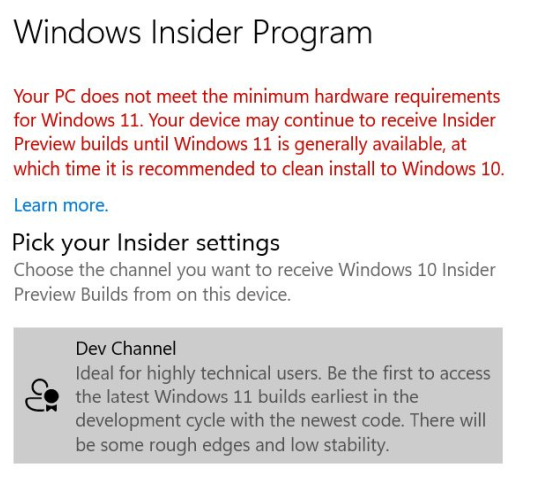Everyone’s quite eager to get their hands on the Windows 11 update. But if there’s one thing that might play spoilsport to their plans for an easy upgrade, it’s the dreaded system requirements error telling them that their PC doesn’t meet the minimum hardware requirements to run Windows 11.
Here’s what you should know about this error and how you may be able to bypass it.
What is the System Requirements Error?
When users with older hardware that doesn’t meet the system requirements for Windows 11 register on the Dev Channel of their Windows 10 PC, Microsoft is giving them this error under System update.
“Your PC does meet the minimum hardware requirements for Windows 11. Your device may continue to receive Insider Preview builds until Windows 11 is generally available, at which time it is recommended to clean install to Windows 10.”

Related:
- How To Get Windows 11 Dev Channel Build on Any PC Not Meeting Requirements
- How To Download Windows 11
What does the System Requirements Error mean?
In a highly controversial move, Microsoft revealed earlier that it is stepping up the minimum hardware requirements that your PC should meet to run Windows 11. Specifically, one’s PC must have UEFI secure boot capability and TPM version 2.0 in order to upgrade to the latest Windows.
But as many have found out, these may either not be available on their PCs or, if available, are disabled by default. (Read: How to enable TPM and Secure boot.) This has understandably raised the collective ire of people who could easily run Windows 10 but cannot upgrade to Windows 11 because their PCs do not meet the hardware requirements to do so.
Although it appears that these hard requirements are here to stay, one can, in practice, get upgraded to Windows 11 if one’s enrolled in the Dev Channel of Windows Insider Program.
Microsoft confirmed in a blog post that it will allow all Windows Insiders to “continue installing Windows 11 Insider Preview builds even if their PC does not meet the minimum hardware requirements.”

Users will be eligible for Windows 11 preview builds only until the final version of Windows 11 is generally available, after which time those who do not meet the minimum hardware requirements will have to revert to Windows 10.
So, that is what it all means. That you will need to downgrade to Windows 10 once Windows 11 is released to the public as further dev builds won’t be available to you if you do not meet the system requirements for Windows 11.
If you’re already a part of the Windows Insider Program but don’t meet the minimum hardware requirements to run Windows 11, you may see the Windows 11 System Requirments Error before installing the update as well. But you can go ahead and install it regardless of the error as per the Limited Exception rule for Windows 11 preview builds.
How to fix
There is nothing to fix here as this is only a warning that says that you will need not get newer dev builds of Windows 11 when it is available for the public. Meaning, you better go back to Windows 10 at that time.
However, if you switch from Dev channel to beta channel or release preview, then this warning will be removed, but you will not get Windows 11 Dev Channel Insider build either. You will get only Windows 10 beta or release preview builds.
Can’t install Windows 11?
You can register for the Dev Channel builds on Windows 10 itself and then upgrade to Windows 11 even if it throws the warning in your face.
But in case the installation doesn’t process and you get a “This PC can’t run Windows 11” error, then we can be of some help here. See our guide on bypassing the TPM 2.0 and Secure Boot requirements below. This will allow you to fix the “This PC can’t run Windows 11” error and install Windows 11 on your older PCs.
► Windows 11 Without TPM: How To Bypass the TPM Requirement and Install the OS
Using the link above, you can install Windows 11 without meeting minimum hardware requirements.
It is possible that after gathering user feedback and understanding more about how Windows 11 runs on different systems and CPU models, Microsoft may adjust the minimum system requirements in the future. But as of now, that doesn’t seem to be a likely scenario.












Discussion